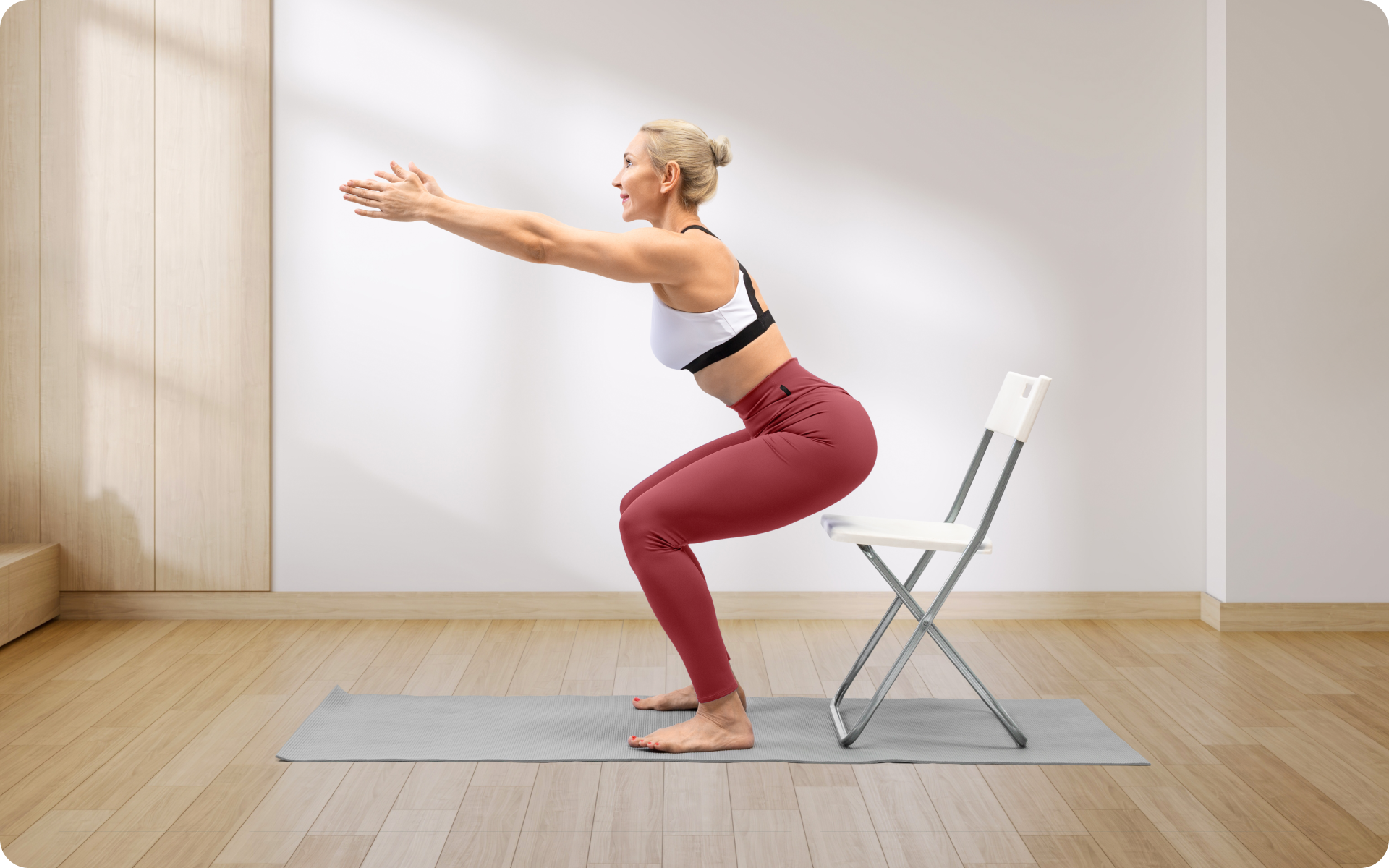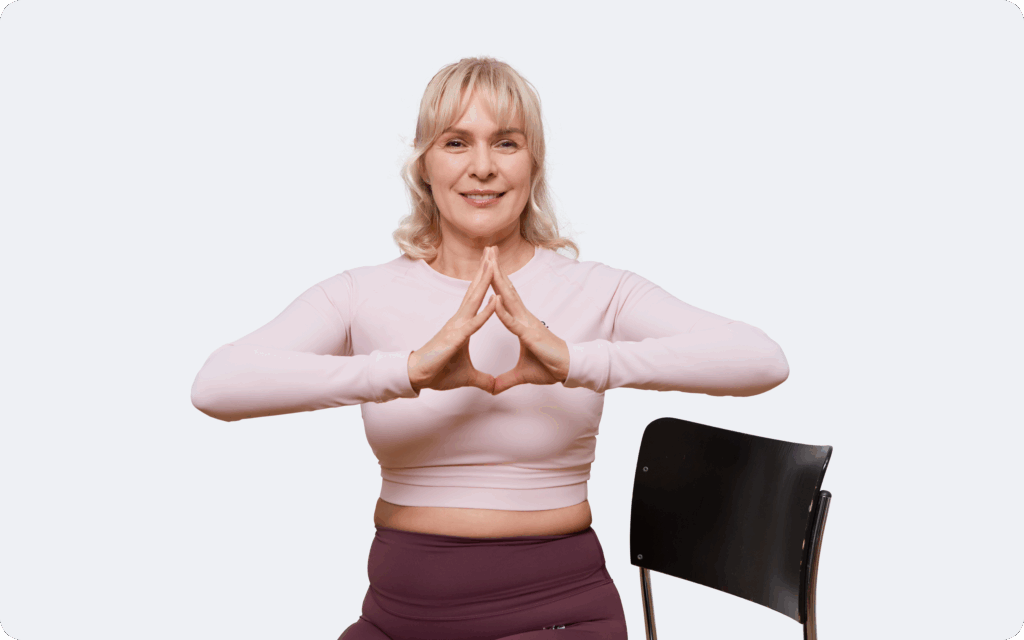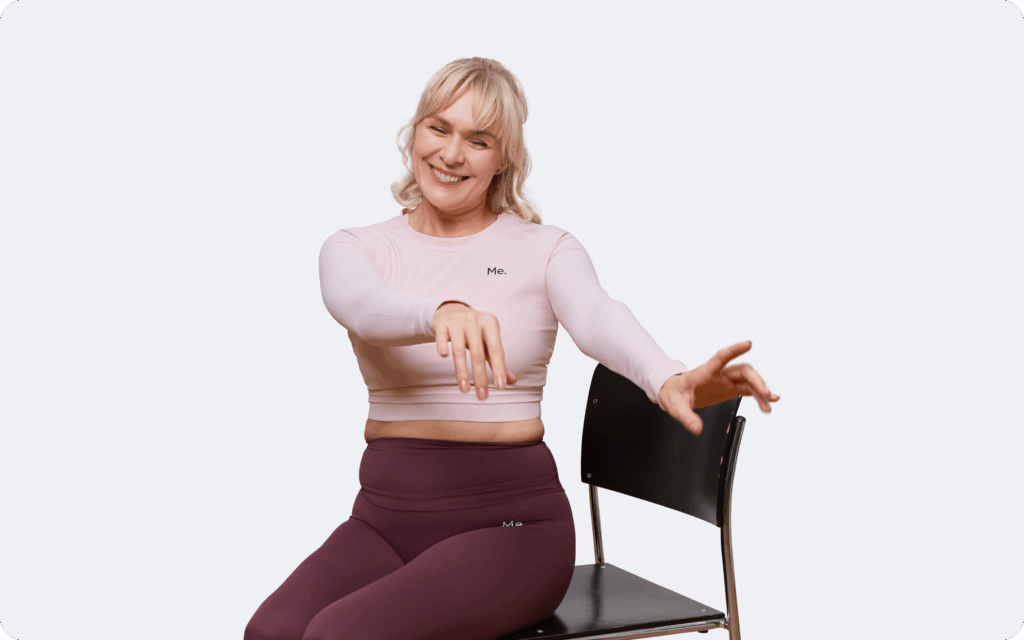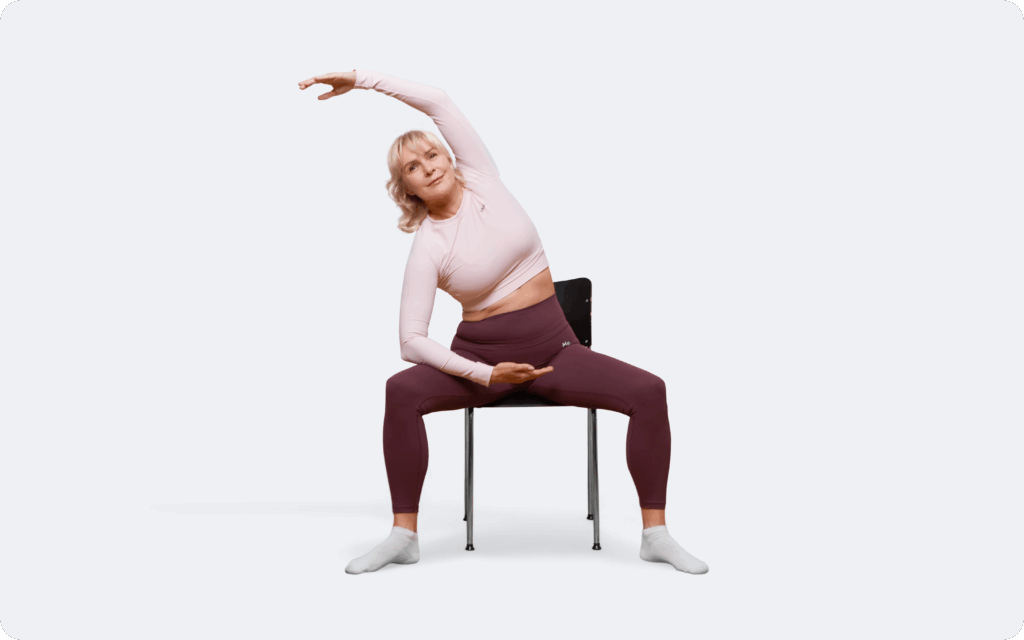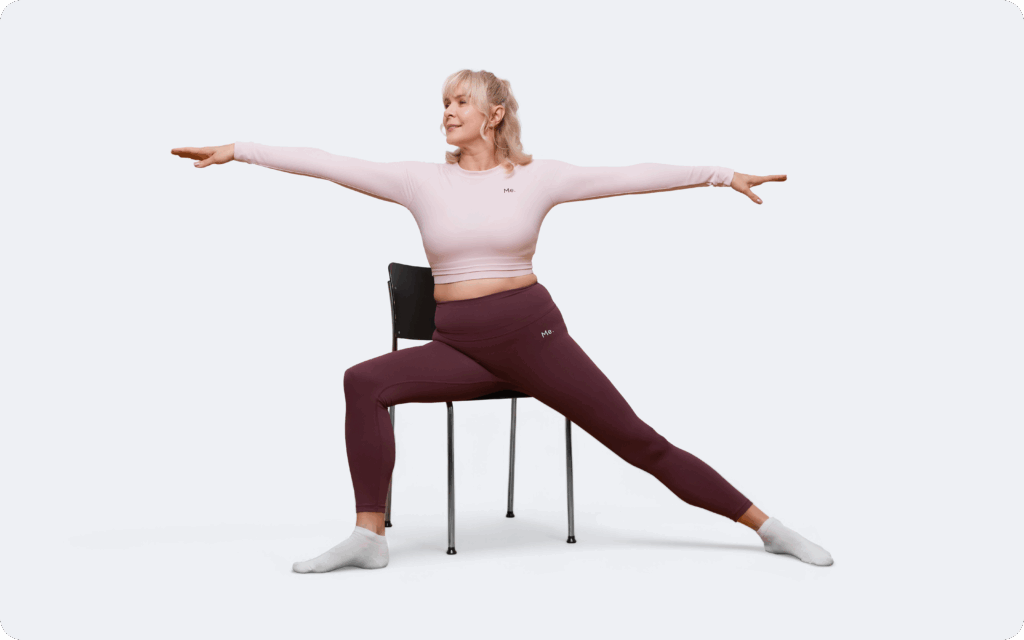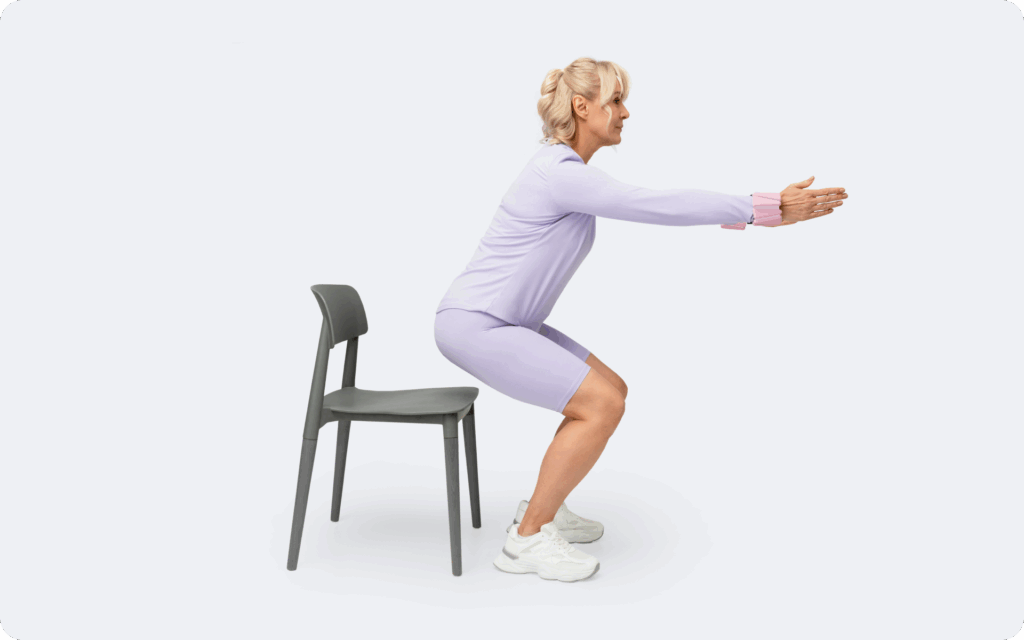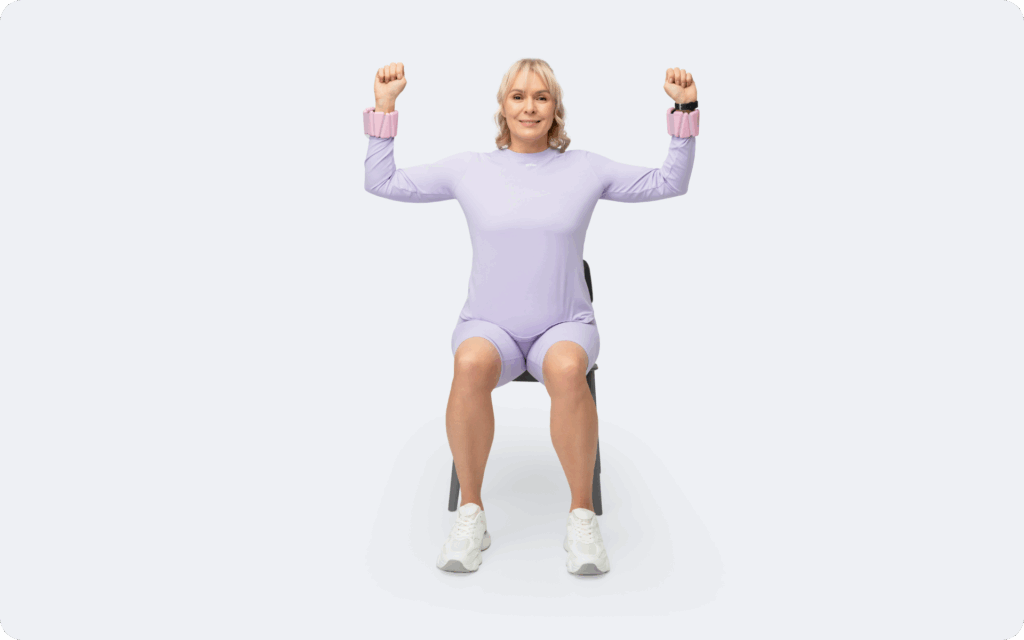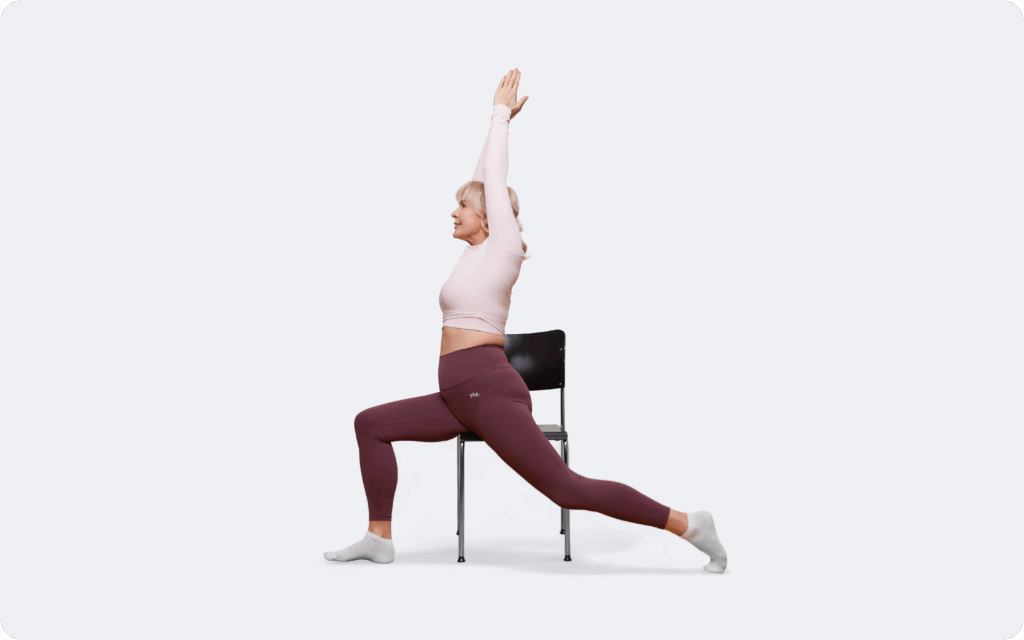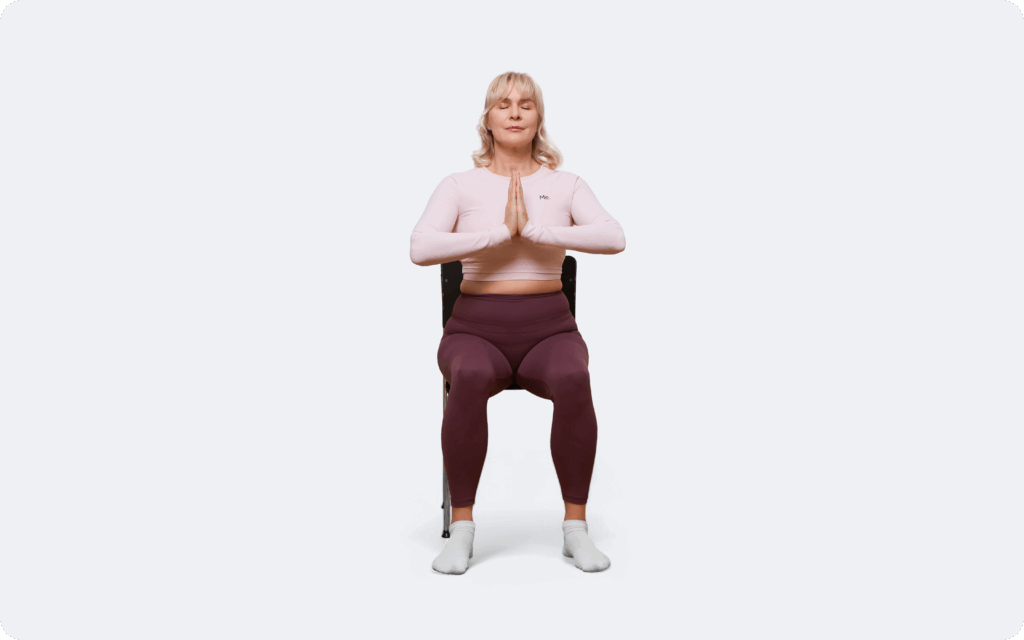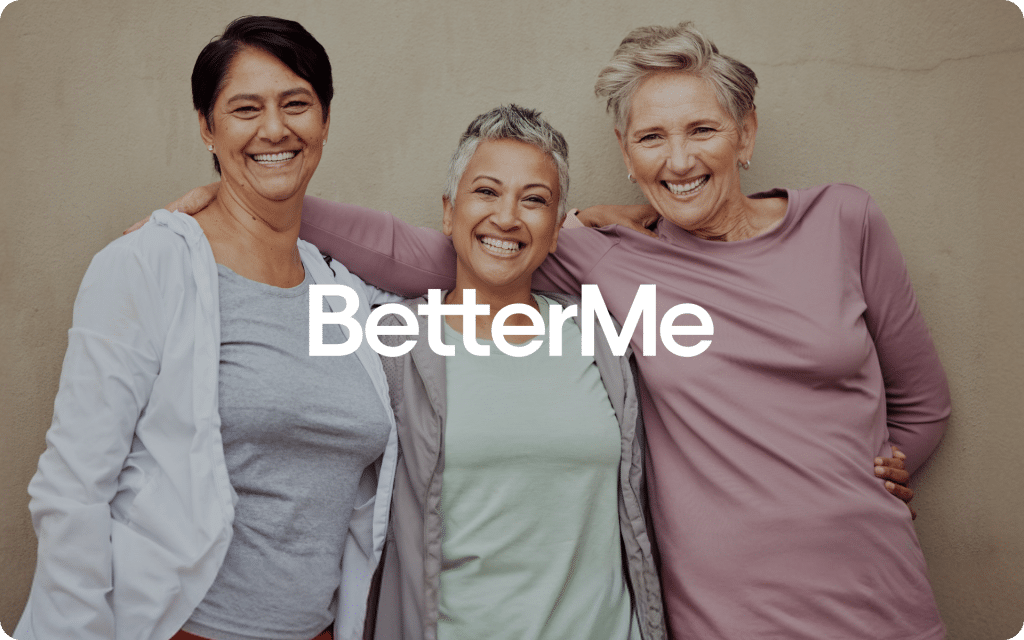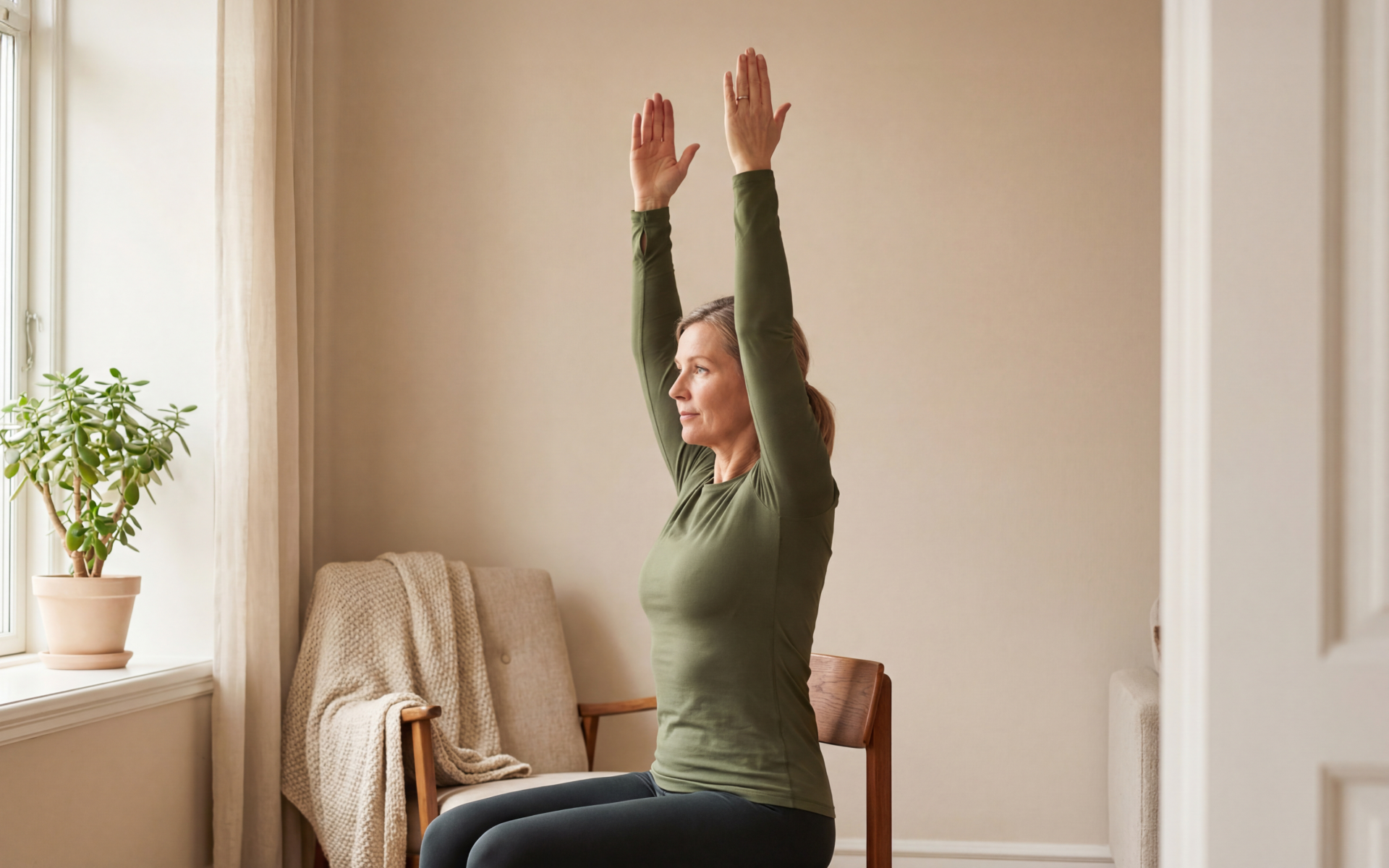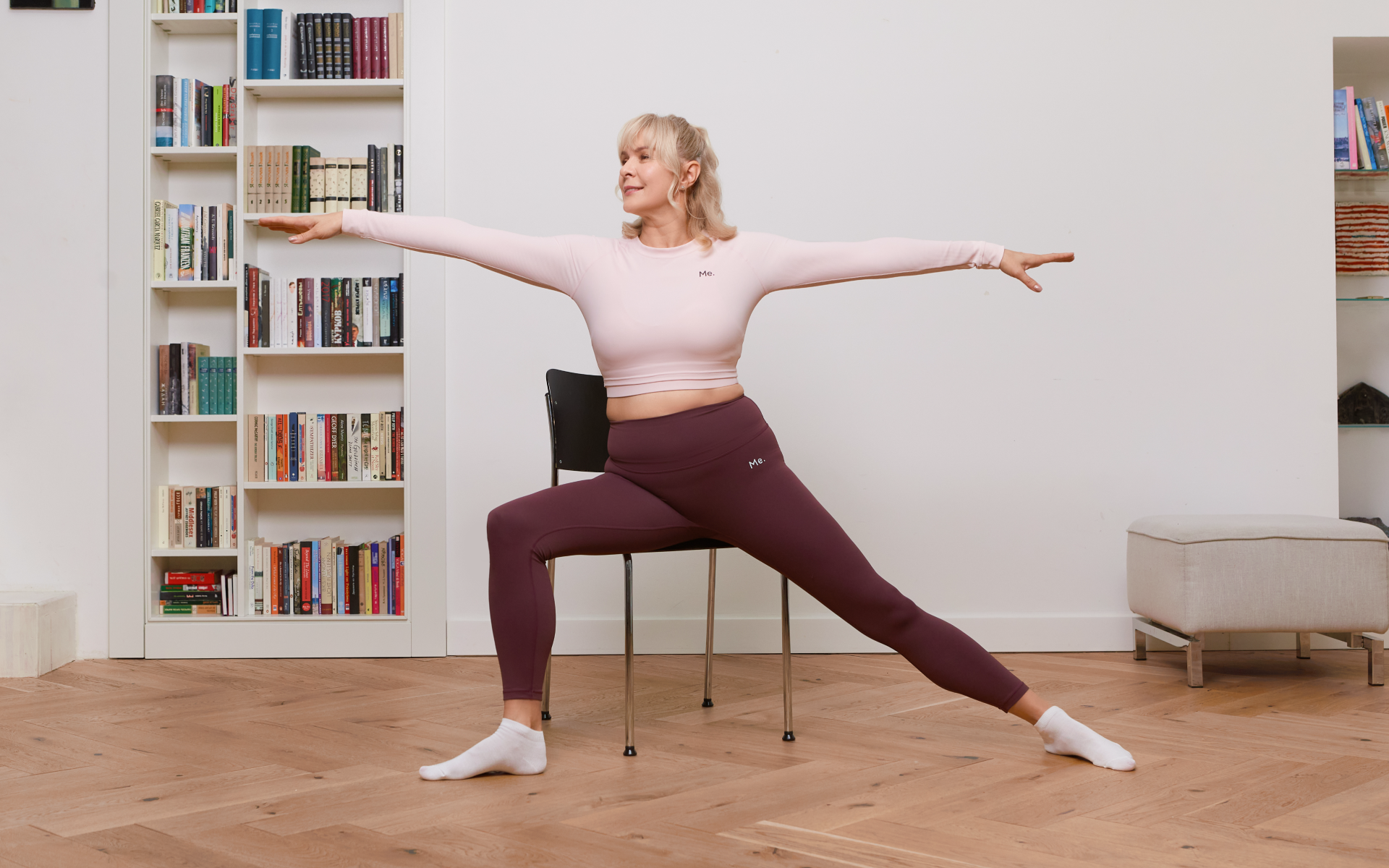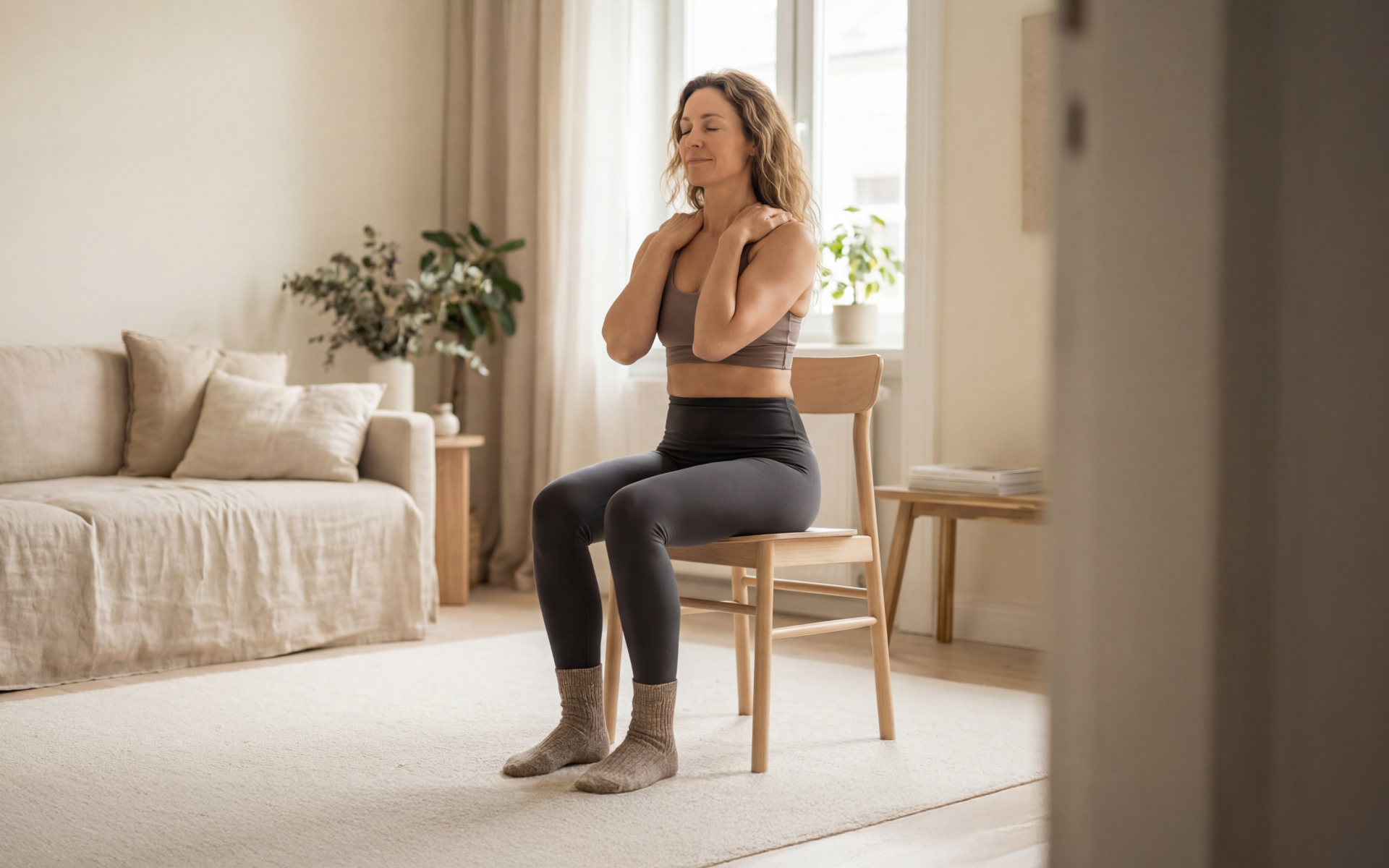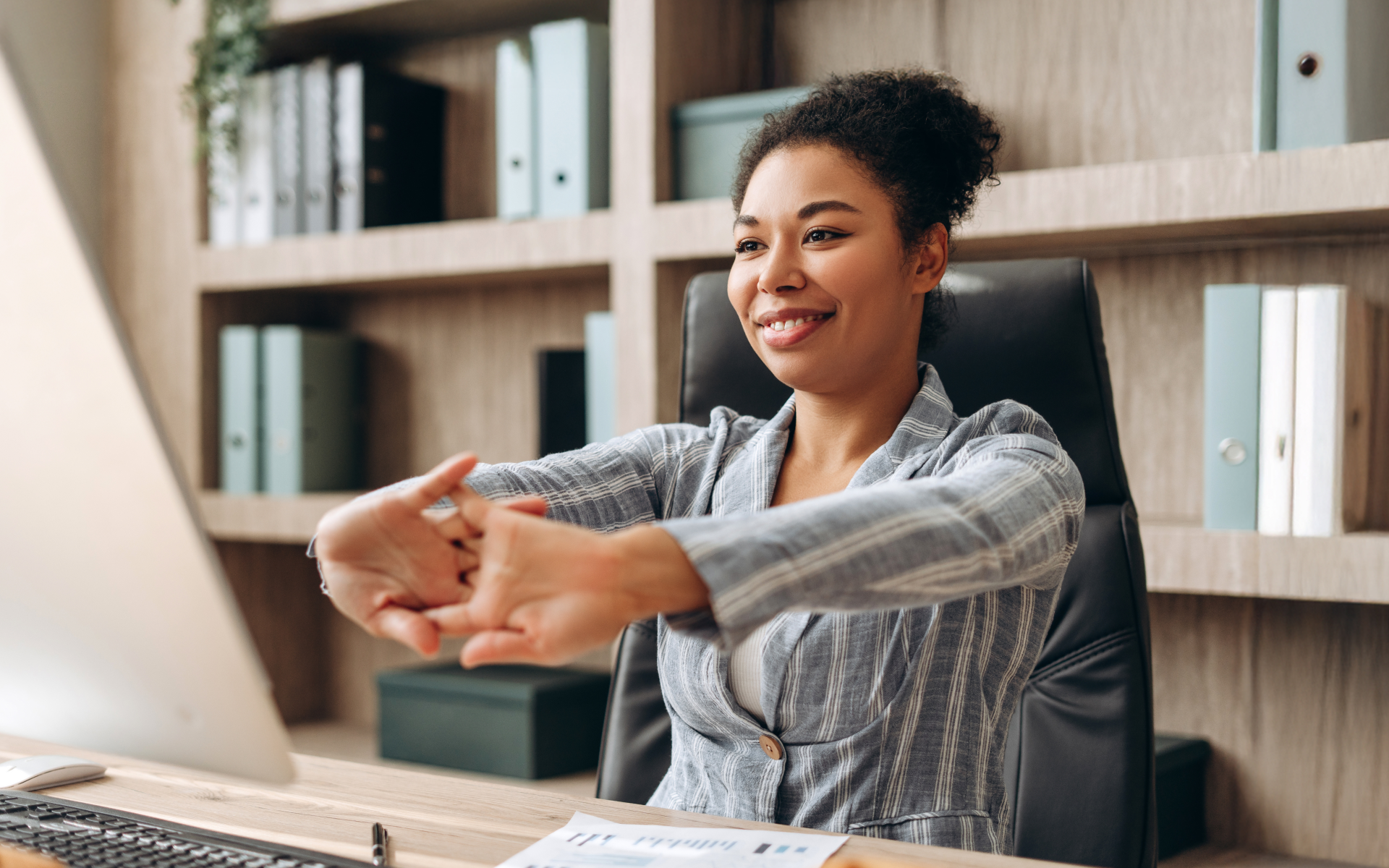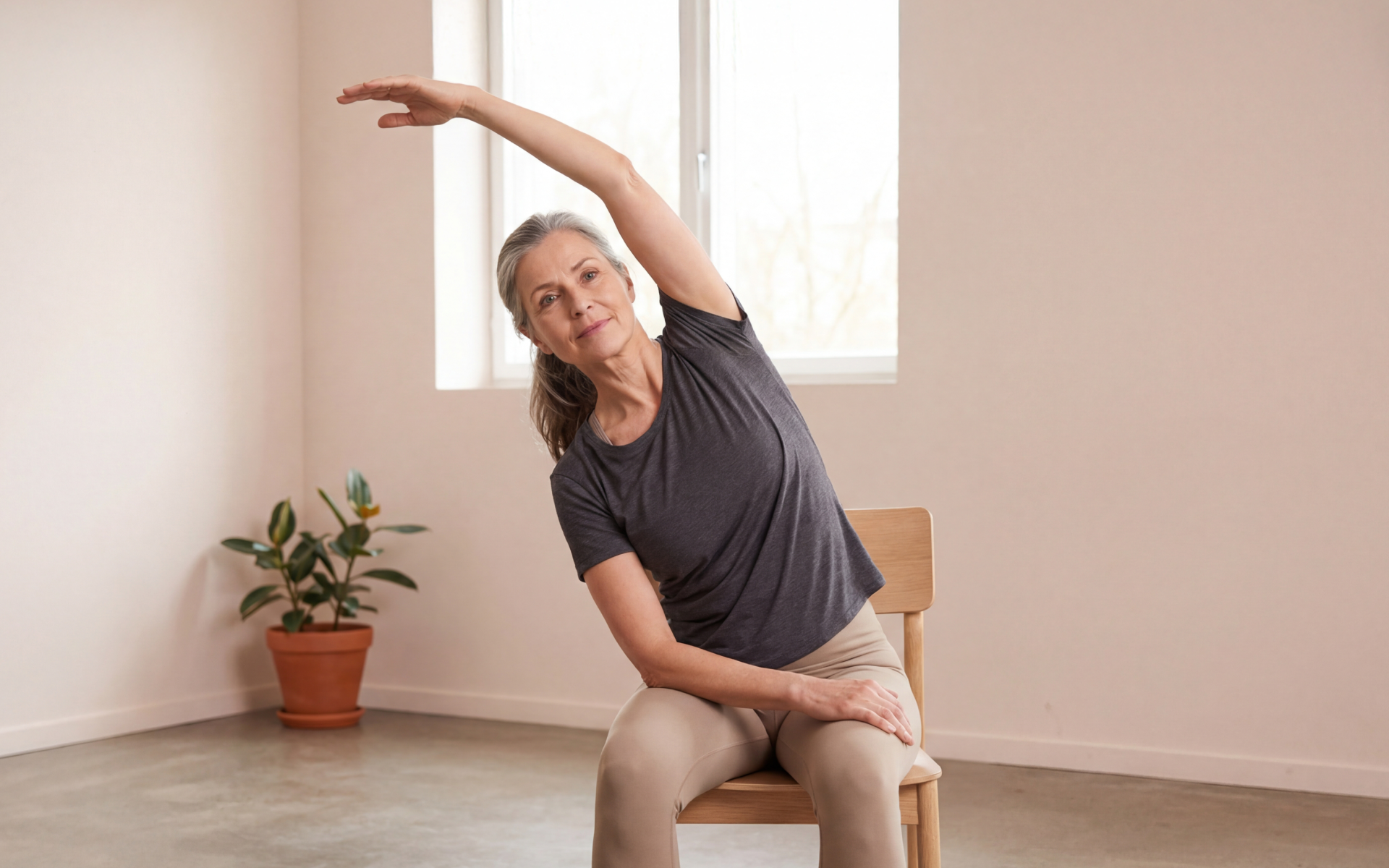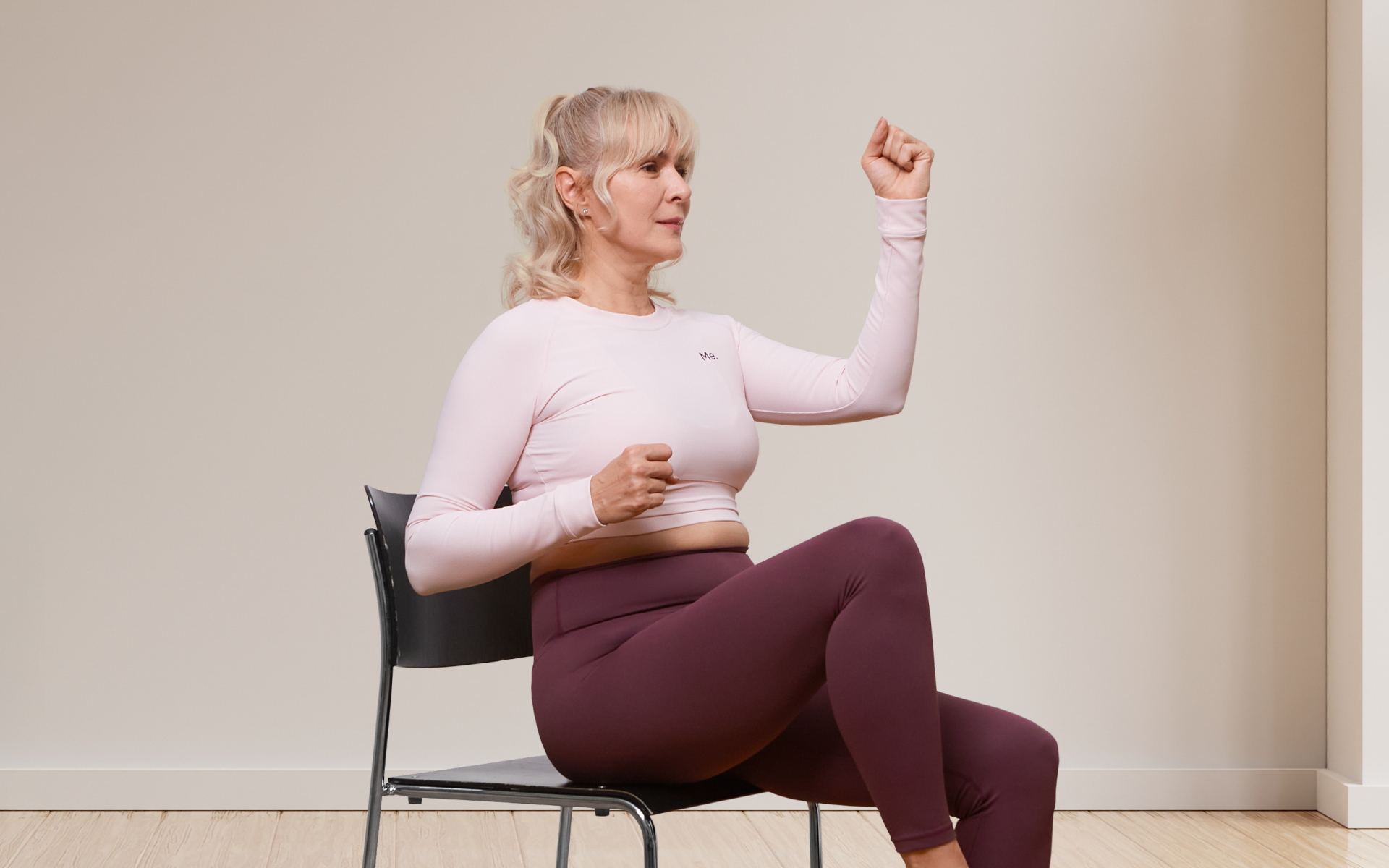In this article, we’ll go through the steps to perform the chair yoga goddess squat (Utkata Konasana) pose. This pose is a variation of the traditional goddess squat that requires standing on your feet. The chair version is perfect for those who have difficulty balancing or cannot stand for extended periods of time.
What Is a Goddess Pose in Chair Yoga?
The goddess pose, known in Sanskrit as Utkata Konasana (pronounced oot-KAH-tuh cone-AHS-uh-nuh), is a foundational posture in yoga. Rooted in ancient practices, it symbolizes strength, grounding, and balance.
When it’s adapted for chair yoga, this pose becomes accessible to individuals with limited mobility or those who need extra support, while still offering key physical and mental benefits.
At its core, the goddess pose mimics a wide-legged squat with knees bent and toes turned slightly outward. However, in chair yoga, these movements are supported by a chair, which allows the practitioner to experience the pose without bearing full weight on their lower body. This makes it ideal for beginners, older adults, or anyone who is recovering from an injury.
BetterMe: Health Coaching app helps you achieve your body goals with ease and efficiency by helping to choose proper meal plans and effective workouts. Start using our app and you will see good results in a short time.
The Meaning Behind the Pose
The Sanskrit name Utkata translates to “fierce” or “intense” and Kona means “angle”. Together, they describe the strong, wide stance that embodies a sense of empowerment and stability.
Many see the goddess squat as an homage to the fierce energy of goddesses in ancient traditions. Practicing this posture can remind us to root down, channel strength, and remain open to balance, both physically and mentally.
How the Pose Works in Chair Yoga
Anatomically, the goddess pose primarily engages the muscles in your legs and hips, such as the quadriceps, hamstrings, and gluteal muscles. When seated, the range of movement is smaller, which reduces strain and makes it safer for the joints. However, even in this modified form, the pose activates these muscle groups and can improve blood circulation in the lower body.
The hips are a focus area in this pose. Opening the hips, a common goal in yoga, helps increase mobility and prevent stiffness. For many seniors or those with limited mobility, hips can lose flexibility over time. Gentle movements like this are a way to maintain or even improve range of motion (1).
The alignment in the goddess pose targets the spine. When practiced with mindful posture, it promotes lengthening of the upper body and a gentle engagement of the core (the muscles around your abdomen). This supports balance and may also help reduce strain on the lower back during daily activities (2). If you’re curious about chair yoga positions, check out our earlier article.
Bridging Movement and Breath
Breathwork, known as pranayama (pra-NAH-yuh-muh), is deeply intertwined with yoga. When practicing the goddess pose, gentle inhales and exhales guide each movement.
For example, when opening the knees wider or lifting the arms, an inhale naturally accompanies the motion. Exhaling as you return to the starting position or deepen into stillness adds rhythm and control. This synchrony between breath and movement fosters mindfulness and relaxation (3).
Read more: How To Practice Somatic Chair Yoga At Home As A Beginner
How to Do a Chair Yoga Goddess Squat Properly
Practicing the chair yoga goddess squat (Utkata Konasana) properly is essential to reap its benefits while ensuring safety and comfort. Below, you’ll find step-by-step guidance to help you align your body, stabilize your movements, and connect with your breath.
This modified version supports your body with a chair, which makes the pose accessible to individuals with varying levels of mobility.
Step-by-Step Instructions
- Set up Your Space
- Sit toward the edge of a sturdy chair with both feet flat on the ground.
- Ensure your knees are directly above your ankles and approximately hip-width apart.
- Position your chair so it provides a stable base on a non-slip surface.
- Find Your Alignment
- Sit tall, lengthening your spine.
- Roll your shoulders back and down to avoid slouching.
- Activate your core muscles gently by drawing your belly button slightly inward. This helps protect your lower back.
- Adjust Your Foot Placement
- Separate your feet wider than hip-width apart, creating a comfortable V-shape with toes pointing diagonally outward. This mimics the traditional Utkata Konasana stance.
- Keep your feet firmly grounded to maintain stability.
- Begin the Movement
- Place your hands on your thighs for stability. If you feel secure, you can extend your arms outward or upward to enhance the pose.
- Gradually bend your knees outward, engaging your inner thighs and hips. Focus on opening your hips.
- Keep your back straight and avoid leaning forward or collapsing into the chair.
- Engage and Hold
- Maintain gentle engagement in your quadriceps (front thigh muscles), hamstrings (back thigh muscles), and gluteal muscles (buttocks).
- Hold the position for 3–5 breaths, or whatever duration feels comfortable. Use slow, deep breathing to promote relaxation (inhale deeply through your nose, exhale gently through your nose or mouth).
- Return to the Starting Position
- On an exhale, slowly return your knees back to their neutral position.
- Lower your arms (if they were lifted) and relax your muscles.
- Rest for a few moments before repeating if desired.
Whether you’re a workout beast or just a beginner making your first foray into the world of fitness and dieting – BetterMe has a lot to offer to both newbies and experts! Install the app and experience the versatility first-hand!
Key Tips for Proper Form
- Hip-Friendly Movements
If your hips feel tight, don’t force the rotation. Focus on small, gentle movements while gradually working to open your hips over time. - Avoid Knee Strain
Ensure your knees track in the same direction as your toes to avoid unnecessary pressure on the joint. - Engage Your Core
Your core stabilizes your spine and supports your overall balance during the pose. - Modify If Needed
If reaching the floor feels challenging, place a yoga block or folded blanket under your feet for extra support. You can also reduce the width of your stance until it feels comfortable.
Breath Connection
The goddess squat involves combining pranayama (breath control) with movement. Syncing your breath with each phase of the pose helps create a fluid and mindful practice:
- On the movement outward (knees opening), take a slow, steady inhale to encourage expansion and strength.
- On returning inward (knees closing or relaxing posture), exhale fully to release tension and maintain control.
What to Focus on
- Hips and Inner Thighs
The external rotation of your hips stretches and strengthens your adductors, the inner thigh muscles that play a key role in stabilizing your lower body. - Quadriceps and Glutes
The goddess squat lightly activates these muscle groups even in a seated position, which improves strength and endurance over time. - Spinal Alignment
Keeping your spine upright prevents unnecessary strain on the lower back, which promotes healthy posture. - Knee Joints
By distributing weight evenly through your feet, the movement supports proper knee alignment, which is particularly important for individuals with arthritis or reduced joint stability.
Take It Slow and Steady
The chair yoga goddess squat is meant to be a gentle yet empowering posture. Whether you’re new to yoga or are adapting it due to mobility concerns, this pose can be tailored to your needs. Consistency and patience will help you feel stronger, more stable, and confident in your practice.
For more details about seated chair yoga poses, take a look at our prior publication.
Read more: 5 Minute Chair Yoga for Beginners to Ease Muscle Stiffness
Is the Chair Yoga Goddess Squat Difficult?
Whether the chair yoga goddess squat (Utkata Konasana) is difficult depends on your individual mobility, flexibility, and current physical condition. While chair yoga provides extra support, it’s not entirely without challenges.
Here are some factors that could make the goddess squat feel challenging for some:
1. Limited Hip Mobility
The goddess squat requires your hips to externally rotate (turn outward), which can feel stiff or restricted, particularly for those who sit for long hours or have conditions such as arthritis. Limited hip flexibility may result in less range of motion, but this can be adapted with gentle progressions.
2. Knee Discomfort
For individuals with knee issues, the bent-knee position may feel awkward. While the chair supports your weight, the movement still engages knee joints. Adjusting how deeply you bend your knees or keeping a smaller stance can help minimize strain.
3. Core Activation
Mindfully engaging the core muscles (the group of muscles around your abdomen) is key for stability. Some may find this difficult if their core strength is underdeveloped or if they’re not used to maintaining an upright posture during movement. However, placing your hands on your thighs for added stability can be helpful.
4. Coordination Issues
Synchronizing breath with movement requires focus. For beginners, coordinating body alignment, breath (pranayama), and muscle activation can seem overwhelming at first. With practice, this will become more intuitive.
5. Fatigue in the Lower Body
The quadriceps (front thigh muscles), hamstrings (back thigh muscles), and gluteal muscles (buttocks) work to hold the pose, even in the supported form. If these muscles are weak or deconditioned, fatigue may set in quickly. This is normal and can improve with consistent practice.
6. Balance and Awareness
The goddess squat involves opening the knees wide while keeping a stable base of support (typically through flat feet). For some, this requires a level of body awareness and balance that may initially feel unfamiliar. Chair yoga minimizes the risk of falling but still asks for conscious engagement.
Addressing the Challenges
The good news is that many of these challenges can be managed with modifications and mindful adjustments. For example:
- Using blocks or cushions under your feet can help if your legs lack flexibility or don’t reach the floor comfortably.
- Smaller movements (such as shallow bends) are just as effective for beginners or those with joint issues.
- Pausing for rest between repetitions allows muscles to recover.
What Are the Benefits of the Goddess Squat?
The chair yoga goddess squat (Utkata Konasana) offers a variety of benefits for both body and mind. Although it’s a modified version of the traditional pose, it still provides an excellent way to strengthen, stretch, and connect with your body:
Physical Benefits
- Strengthens Key Muscles
The goddess squat works your quadriceps (front thigh muscles), hamstrings (back thigh muscles), and gluteal muscles (buttocks). Even in its seated form, it engages these muscle groups to improve strength and endurance over time (4).
- Supports Hip Mobility
This pose gently opens the hips through external rotation, which improves flexibility in the adductors (inner thigh muscles) and surrounding ligaments. Restoring or maintaining hip mobility is essential for daily activities such as walking or climbing stairs (5).
- Encourages Spinal Alignment
With a focus on sitting tall and activating the core, Utkata Konasana promotes proper posture. Good spinal alignment can reduce tension in the lower back and neck, areas that are commonly stressed in seated lifestyles (6).
- Improves Joint Stability
By bending the knees outward and keeping the feet grounded, the pose strengthens the stabilizing muscles around the knee joints. This can be particularly beneficial for individuals with arthritis or reduced joint stability (7).
- Enhances Circulation
Activating large muscle groups in the lower body encourages better blood flow. Improved circulation can help prevent stiffness (8), particularly for those who remain seated for long periods.
Mental and Emotional Benefits
- Fosters Mindfulness
Syncing breath with movement bridges the gap between body and mind. This mindful awareness encourages relaxation and can reduce stress levels (9).
- Boosts Confidence
The wide stance and open posture of the goddess squat symbolize strength and empowerment. Practicing this pose often generates feelings of grounding and self-assurance.
- Promotes Relaxation
Deep breathing (pranayama) during the pose signals the nervous system to relax. Gentle practices like this can be soothing, particularly for those who are dealing with anxiety or tension (9).
Functional Benefits
- Accessible Movement
The chair provides support, which makes this posture suitable for individuals of various fitness levels or with mobility restrictions. It allows practitioners to build strength and flexibility without causing strain.
- Prepares the Body for Daily Activities
By targeting functional movement patterns such as squatting and hip opening, the goddess squat helps improve motion used in day-to-day tasks. Simple actions, such as sitting down, standing up, or stepping sideways, can feel easier with consistent practice.
- Helps Maintain Balance
Gentle engagement of the core and lower body improves overall stability. For seniors or beginners, this can reduce the risk of falls or imbalance in daily life.
Our previous post goes into great detail about the chair pose yoga benefits.
Is Chair Yoga Actually Effective?
Yes, chair yoga can be highly effective, particularly for individuals with limited mobility or those who are new to yoga. By adapting traditional poses with the support of a chair, it creates a safe, accessible way to improve strength, flexibility, and balance without overexertion (10).
Chair yoga bridges the gap for individuals who may find floor-based yoga intimidating or unsafe. It allows practitioners to build foundational skills, restores their confidence in movement, and helps them engage in mindfulness practices. For seniors or beginners, it’s a gentle yet impactful way to promote overall wellness.
The goddess pose is associated with the Sacral Chakra (Svadhisthana). This energy center is located in the lower abdomen and is connected to creativity, emotional balance, and sensuality. Practicing this pose can stimulate and balance this chakra. Difficulty with the goddess pose often comes down to limited hip flexibility, tight inner thigh muscles, or a lack of strength in the legs and core. Mobility challenges or joint discomfort may also play a role. Using props such as a chair or adjusting your range of motion can make the pose more accessible. The key difference lies in their orientation and use. The horse stance is rooted in martial arts and emphasizes stability and strength with arms bent in front of the body. On the other hand, the goddess pose is a yoga posture with arms extended upward or out to the sides, focusing on balance, hip opening, and mindfulness. Yes, the goddess squat is a gentle hip opener. By externally rotating the hips and engaging the inner thighs, it improves flexibility in the hip joint and surrounding muscles, which makes it a beneficial pose for increasing mobility.Frequently Asked Questions
What chakra is activated by the goddess pose?
Why can’t I do a goddess pose?
What is the difference between horse and goddess pose?
Is the goddess squat a hip opener?
The Bottom Line
The goddess pose in chair yoga blends tradition with accessibility. It honors yoga’s ancient wisdom while meeting the needs of modern practitioners who value gentle, safe modifications. For many, it offers the chance to explore strength, balance, and flexibility without fear of overexertion or imbalance.
By adapting poses such as Utkata Konasana, chair yoga continues to prove that meaningful movement is for everyone. Whether you’re a beginner, a seasoned yogi who is looking for a restorative practice, or someone who is exploring movement later in life, the goddess pose offers a chance to connect with your body and spirit at your own pace.
DISCLAIMER:
This article is intended for general informational purposes only and does not serve to address individual circumstances. It is not a substitute for professional advice or help and should not be relied on for making any kind of decision-making. Any action taken as a direct or indirect result of the information in this article is entirely at your own risk and is your sole responsibility.
BetterMe, its content staff, and its medical advisors accept no responsibility for inaccuracies, errors, misstatements, inconsistencies, or omissions and specifically disclaim any liability, loss or risk, personal, professional or otherwise, which may be incurred as a consequence, directly or indirectly, of the use and/or application of any content.
You should always seek the advice of your physician or other qualified health provider with any questions you may have regarding a medical condition or your specific situation. Never disregard professional medical advice or delay seeking it because of BetterMe content. If you suspect or think you may have a medical emergency, call your doctor.
SOURCES:
- Meta-Analysis of the Effect of Yoga Practice on Physical Fitness in the Elderly (2021, mdpi.com)
- Anatomical Correlation of Core Muscle Activation in Different Yogic Postures (2017, journals.lww.com)
- Yoga breathing, meditation, and longevity (2009, nih.gov)
- Improvement in muscular strength, body flexibility and balance by yoɡasana and with reduced detraining effects by yoɡa breathing maneuvers: A non-randomized controlled study (2023, nih.gov)
- Systematic Review of the Importance of Hip Muscle Strength, Activation, and Structure in Balance and Mobility Tasks (2023, nih.gov)
- Yoga as a treatment for chronic low back pain: A systematic review of the literature (2016, nih.gov)
- The Effects of Yoga on Pain, Mobility, and Quality of Life in Patients with Knee Osteoarthritis: A Systematic Review (2016, nih.gov)
- Regulation of Increased Blood Flow (Hyperemia) to Muscles During Exercise: A Hierarchy of Competing Physiological Needs (2015, nih.gov)
- Breath of Life: The Respiratory Vagal Stimulation Model of Contemplative Activity (2018, frontiersin.org)
- Chair Yoga and Why Seated Yoga Poses Are Good For You (2023, brownhealth.org)
